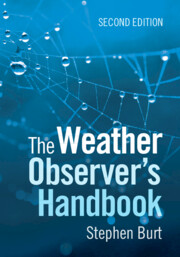Book contents
- The Weather Observer’s Handbook
- Reviews
- The Weather Observer’s Handbook
- Copyright page
- Dedication
- Epigraph
- Contents
- Foreword
- Acknowledgements
- Author’s note
- Abbreviations, footnotes and references
- Part I The basics
- Part II Measuring the weather
- 4 Site and exposure: The basics
- 5 Measuring the temperature of the air
- 6 Measuring precipitation
- 7 Measuring atmospheric pressure
- 8 Measuring humidity
- 9 Measuring wind speed and direction
- 10 Measuring grass and earth temperatures
- 11 Measuring sunshine and solar radiation
- 12 Observing hours and time standards
- 13 AWS data flows, display and storage
- 14 Non-instrumental weather observing
- 15 Calibration
- 16 Metadata: What is it, and why is it important?
- Part III Making the most of your observations
- Book part
- References and Further Reading
- Index
7 - Measuring atmospheric pressure
from Part II - Measuring the weather
Published online by Cambridge University Press: 21 May 2024
- The Weather Observer’s Handbook
- Reviews
- The Weather Observer’s Handbook
- Copyright page
- Dedication
- Epigraph
- Contents
- Foreword
- Acknowledgements
- Author’s note
- Abbreviations, footnotes and references
- Part I The basics
- Part II Measuring the weather
- 4 Site and exposure: The basics
- 5 Measuring the temperature of the air
- 6 Measuring precipitation
- 7 Measuring atmospheric pressure
- 8 Measuring humidity
- 9 Measuring wind speed and direction
- 10 Measuring grass and earth temperatures
- 11 Measuring sunshine and solar radiation
- 12 Observing hours and time standards
- 13 AWS data flows, display and storage
- 14 Non-instrumental weather observing
- 15 Calibration
- 16 Metadata: What is it, and why is it important?
- Part III Making the most of your observations
- Book part
- References and Further Reading
- Index
Summary
Atmospheric pressure is one of the most important of all meteorological elements. Fortunately, it is also the easiest of all to measure, particularly with modern sensors, and even basic instruments such as household aneroid barometers or smartphones can provide reasonably accurate readings. To ensure consistent and reliable readings for professional applications, for instance aviation requirements, it is essential that pressure sensors are correctly exposed: World Meteorological Organization recommendations on exposure and instrument accuracy are included. Instructions are given to correct or ‘reduce’ observed atmospheric pressure readings to a standard level, usually mean sea level (MSL), and to check and adjust the calibration of pressure sensors to avoid calibration drift, which can become substantial if not corrected. Methods for doing this are explained, with examples.
Keywords
- Type
- Chapter
- Information
- The Weather Observer's Handbook , pp. 187 - 203Publisher: Cambridge University PressPrint publication year: 2024

